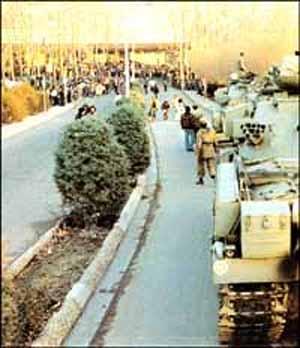General Ramtin's Account of How to Store Weapons
Compiled by: Islamic Revolution Website
Translated by: Fazel Shirzad
2024-10-29
I remember that we were in Bakhtiar's Palace on the night of 22 Bahman (10th February). There was also wireless telephone. Two or three of my colleagues and I were in the telephone room, and according to the words of the police officers whose wireless telephone was on; We heard that the police station fell down somewhere, the police station fell down here and there. Then we talked and said to come and get Bakhtiar tonight. Bakhtiar belonged to the upper class. Another thing is that there is a police station at the first of Jami Street, which was called "Center Police Station" at that time. On the wireless telephone, we could hear an officer saying that people have dropped, what should I do with the guns? The one who was talking to him said: I don't know what to do. He said: I can keep two or five of them, what should I do with the rest? This issue made me think about the storage of weapons and that we should keep and preserve these weapons in any way possible. Then with some colleagues, we started to bring weapons and collected them and appointed some people to guard them; because we heard that the people of the gangs had brought a number of Afghans and told them to go and get whatever weapons and ammunition there are and bring them and we will give you two thousand tomans (Iranian currency). Later, the issues that the hypocrites raised for the revolution probably originated from here. Well, that's what we came up with after hearing that wireless and figured out what to do in that situation. Of course, before these talks happen at all; the army was with the people and had no problem with them. We thank God, we did it, and Alhamdulillah, not a single needle point was lost from our weapons and we used all of them twice. Six days had passed since the victory of the revolution; That is, on February 28, I was at home at two in the morning when they said that Sanandaj was crowded.

I got up at two o'clock and came, ten or twelve of these comrades, some of whom have now been martyred, I called and they came with guns and a truck. In short, we used the same weapons in the missions that happened in Sanandaj and in other places.[1]
[1] Source: Oral History of the Army in the Islamic Revolution, edited by Heshmatullah Azizi, Tehran, Islamic Revolution Documentation Center, 2016, pp. 97-98.
Number of Visits: 859








The latest
Most visited
How to send Imam's announcements to Iran
In the first part, the issue of funds, Hajj Sheikh Nasrallah Khalkhali - who represented most of the religious authorities - was also the representative of Imam. In Najaf, there was a money exchange office that cooperated with the money exchange offices in Tehran. Some of the funds were exchanged through him.Operation Beit al-Moqaddas and Liberation of Khorramshahr
After Operation Fat’h al-Mobin, we traveled to Kermanshah and visited Sar-e-Pol-e-Zahab before heading to Ilam. During Operation Beit al-Moqaddas, the 27th Brigade was still receiving support from the West. We maintained contact with individuals who had previously worked in Area 7 and were now leading the brigade. It was through these connections that I learned about Operation Beit al-Moqaddas.Memoirs of Hujjat al-Islam Reza Motalebi
Hujjat al-Islam Reza Motalebi is a cleric from Isfahan. Before the revolution, he was the imam of the Fallah Mosque – which was later renamed Abuzar Mosque. By his presence and efforts, Abuzar Mosque soon became a base for supporters of the Imam and the revolution. After the victory of the revolution, he played a role in uniting forces and maintaining political vitality in southwest Tehran.The Necessity of Receiving Feedback in Oral History
Whenever we engage in a task, we naturally seek ways to evaluate our performance — to correct shortcomings and enhance strengths. Such refinement is only possible through the feedback we receive from others. Consider, for instance, a basketball player whose shots are consistently accurate; should he begin shooting blindfolded, his success rate would rapidly decline, as he would be deprived of essential feedback from each attempt.

